The Baby's Mind – Its Memory
A computer is basically a calculator with memory to store information such as the values it is currently working on and where it is up to in a list of instructions. The major development of the Baby was an electronic memory that could be reprogrammed. The Baby used 3 Williams tubes for storage and one as a repeater for the display.

Williams Tubes – The Baby's Memory
Cathode ray tubes (CRTs), just like those found in some (before LCD) TV sets and monitors, lie at the centre of the Baby's memory. 60 years ago CRTs were widely used in radar as an image persisted for a few seconds between updates as it scanned round the screen.
The Baby used this persistence to store data in a large grid, with bright and dim dots representing either a one or a zero. It's not too difficult to crack this 'binary' code to see what all these dots mean.
Binary
The series of ones and zeros is just a convenient way for computers to code numbers as signals need only to be on or off. A signal on a wire is represented by writing 1 for on and 0 for off . This binary coding method used by the Baby is still used just the same in computers today. The words 'Binary Digit' became shortened to bit, which is the smallest unit of storage in computing. You can read more about binary numbers on wikipedia http://en.wikipedia.org/wiki/Binary_numeral_system.
 |
 |
 |
 |
Binary:0000 | Decimal:0 |
Question: What is the decimal value of 1011? Click to flip the switches to find out. What is 7 in binary?
Seeing Inside The Baby's Mind
The dots you can see on the display is literally what is inside the Baby's memory – each bright dot is a 1 and dim dot a 0. With this in mind, (and that binary is just a way of coding numbers) the Williams Tube can be considered as just a way of storing an indexed list of numbers. The numbers in this list represent instructions for the computer to perform or values used in calculations. Each row of 32 dots represents an instruction for the Baby to perform. With 32 of these rows, programs for the Baby can contain 32 operations. You can find out more about what these operations in Instructing the Baby.
An important aspect differentiating the Baby from other early computers is that the memory (including the list of instructions telling what to do) can be changed allowing the computer to be programmable and multipurpose, the first of its kind in the world.
Modern computers use silicon chips for memory but share many similarities with the Williams Tube. Instead of charging a large bulky screen, tiny silicon transistors are charged, though they still need to be repeatedly read and recharged, just like the Williams Tube.


